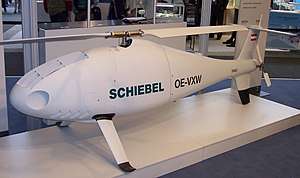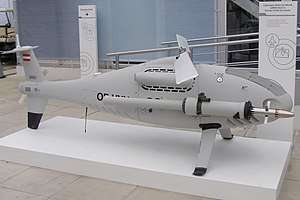Schiebel Camcopter S-100
| Camcopter S-100 | |
|---|---|
 | |
| Camcopter S-100 | |
| Role | UAV |
| Manufacturer | Schiebel |
| Primary users | UAE Army German Navy Chinese Navy Russian Coast Guard |
The Schiebel Camcopter S-100 is an Austrian unmanned aerial vehicle (UAV) using a rotorcraft design.
Design and development
Produced by the Austrian company Schiebel, it was developed from 2003 to 2005. With a maximum take-off weight (MTOW) of 200 kilograms (440 lb), its endurance is 6 hours (extendable to over 10 hours with optional external AVGAS fuel tanks fitted[1]). It has a maximum speed of 220 kilometres per hour (140 mph) and a ceiling of 5,500 metres (18,000 ft). It is powered by a 55 horsepower (41 kW) Diamond engine and can carry various payloads, such as electro-optics and infrared sensors.
On 12 March 2012 Schiebel announced that it successfully tested a company-developed heavy-fuel engine interchangeable with the standard Diamond engine. This heavy-fuel engine allows for the use of JP-5, Jet A-1 or JP-8 jet fuels. These fuels, which are standard on marine vessels, are safer to store and handle than gasoline.[2]
On 7 February 2013, Schiebel flight tested a Thales Group I-Master surveillance radar system on the Camcopter at its Wiener Neustadt, Austria, facility. The I-Master system, weighing 30 kg (66 lb), provides ground moving target indication and synthetic aperture radar operations.[3]
International customers

The launch customer for the S-100 was the UAE Army, which ordered 40 aircraft with an option for 40 more. The aircraft was ordered by three more undisclosed nations, with total orders reaching 200.
The Camcopter underwent sea trials on the Indian Navy's INS Sujata (P56) during October 2007.[4] Flight testing occurred aboard a Pakistan Navy Type 21 frigate in the Arabian Sea on 16 March 2008,[5] with further naval testing on 14 April 2008 on the Spanish Guardia Civil vessel Rio Miño off Gran Canaria.[4][6]
The German Navy conducted testing during three weeks in August and September 2008 on the Braunschweig-class corvettes Braunschweig and Magdeburg, respectively. More than 130 takeoffs were conducted, and the UAV maintained unaided on-deck stability in greater than 15° flight deck roll conditions.[7][8]
The French Navy performed test flights during September and October 2008, with a Camcopter spending four days on a barge in the Atlantic Ocean and a further three days on the frigate Montcalm (D642).[4][9]
Libya ordered four Camcopters in 2009, which were placed under command of the Khamis Brigade.[10]
Jordan ordered two S-100s with L-3 Wescam MX-10 EO-IR payloads in July 2010 and accepted delivery in February 2011.[11]
In November 2011 the Camcopter demonstrated flights from the French Gowind-class corvette L'Adroit.[12] At the same time, the Gorizont (Horizon) Air S-100, a Russian license-built version of the UAV was successfully tested aboard the Coast Guard patrol cutter Rubin. Russia intends to equip all Rubin-class patrol boats with these UAVs.[13]
In 2010 the Chinese Navy purchased 18 of these systems. Two years later, in May 2012, an unmanned UAV believed to be a Camcopter S-100 was photographed operating from the fantail of a Chinese Type 054A frigate by the Japanese Maritime Self Defense Force.[14]
In April 2012, the Camcopter became the first unmanned helicopter to fly from an Italian Navy vessel when it was flight tested from the MM Bersagliere (F-584).[15] In February 2014, the Italian Navy chose the S-100 as its primary unmanned aerial system for shipboard operations, where it will be used for intelligence, surveillance and reconnaissance (ISR). It will additionally support other activities, such as search and rescue and natural disaster recovery.[16]
In December 2014, the Camcopter went through a series of trials in Bizerte, Tunisia, to serve within the Tunisian Army. Schiebel selected the Italian company Leonardo to supply AESA-based SAR radar for the systems which were to enter service in 2017.[17]
In February 2017, the Royal Australian Navy awarded a contract to provide an unrevealed number of Camcopter systems, plus three-years support.[18]
In 2018, the Belgian Navy conducted a weeks-long testing of the Camcopter, assessing its utility for maritime surveillance and search and rescue.[19]
Airframe losses
On 10 May 2012, an Austrian engineer from Schiebel was killed and two South Korean colleagues were injured when a Camcopter S-100 crashed into their control vehicle during a test flight in the South Korean city of Incheon.[20]
On 28 May 2013, Somalia's Harakat al-Shabaab al-Mujahideen reportedly shot down a Camcopter S-100 operated by the U.S. military, and released photographs of the wreckage.[21]
Operators
Governments
Other
Specifications

Data from Schiebel.net (General);[23][24] Armada International (Powerplant 1);[25] Schiebel.net (Powerplant 2)[2]
General characteristics
- Crew: None
- Capacity: 50 kg (110 lb)
- Length: 3.11 m (10 ft 2 in)
- Width: 1.24 m (4 ft 1 in)
- Height: 1.12 m (3 ft 8 in)
- Empty weight: 110 kg (243 lb)
- Max takeoff weight: 200 kg (441 lb)
- Fuel capacity: 57 L (15.5 gal) AVGas 100 LL
- Powerplant: 1 × Austro Engine AE50R Wankel engine, 41 kW (55 hp) (basic)
- Powerplant: 1 × Schiebel heavy fuel engine (optional)
- Main rotor diameter: 3.4 m (11 ft 2 in)
Performance
- Maximum speed: 222 km/h; 138 mph (120 kn)
- Cruise speed: 185 km/h; 115 mph (100 kn)
- Never exceed speed: 241 km/h; 150 mph (130 kn)
- Range: 180 km (112 mi; 97 nmi)
- Endurance: 6 hours
- Service ceiling: 5,500 m (18,000 ft)
- g limits: +3.5 g to -1 g
Armament
- Hardpoints: 2
See also
Related lists
References
- ↑ "AAIB Bulletin" (PDF). Air Accidents Investigation Branch. 8 June 2017. p. 66.
- 1 2 Blama, Andrea (12 March 2012). "Maiden Flight of the Camcopter S-100 with Schiebel's New Heavy Fuel Engine" (PDF) (Press release). Schiebel.net. Retrieved 22 June 2012.
- ↑ Hoyle, Craig (19 February 2013). "Camcopter UAV flies with Thales dual-mode radar". Flight International via FlightGlobal.com. Retrieved 27 May 2013.
- 1 2 3 Pengelley, Rupert (June 2009). "All hands on deck: the sky's the limit for shipboard UAVs" (PDF). Jane's Navy International: 12–13. Archived from the original (PDF) on 26 April 2013.
- ↑ "CamCopter S-100: Shipboard Trials with Pakistani Navy". Defencetalk.com. 17 April 2008. Retrieved 27 May 2013.
- ↑ "Camcopter S-100 Shipboard Trials With Guardia Civil South". ASDNews.com. 18 April 2008. Retrieved 27 May 2013.
- ↑ "Camcopter S-100 completes extensive German Navy flight trials". Shephard Media. 30 September 2008. Retrieved 4 June 2011.
- ↑ "Camcopter S-100 UAV Successfully Completes Deck Landing Trials on K130 Corvettes". Deagle.com. 14 October 2008. Retrieved 4 June 2011.
- ↑ Scott, Richard (14 October 2008). "DCNS claims automatic shipborne UAV recovery breakthrough". Janes.com. Retrieved 16 October 2008.
- ↑ "Rot-weiß-rote Drohnen in Gaddafis Diensten". Der Standard (in German). 1 March 2011. Retrieved 2 March 2011.
- ↑ Putrich, Gayle (23 February 2011). "Jordan gets Schiebel Camcopter S-100". Flight International. Retrieved 22 June 2012.
- ↑ "Schiebel's unmanned helo proves its worth". United Press International via Spacewar.com. 30 November 2011. Retrieved 1 December 2011.
- ↑ На Черном море успешно проведены морские испытания БЛА вертолетного типа. Military Paritet (in Russian). 29 November 2011. Retrieved 27 June 2012.
- ↑ Waldron, Greg (18 May 2012). "Schiebel Camcopter S-100 operated from Chinese frigate". Flight Global. Retrieved 18 May 2012.
- ↑ "First drone-helicopter to take-off from an Italian navy ship". AvioNews. 3 May 2012. Retrieved 27 August 2014.
- ↑ Cenciotti, David (31 May 2014). "The Italian Navy is testing a tiny Camcopter drone from its amphibious warfare ship". The Aviationist. Retrieved 27 August 2014.
- ↑ Khan, Bilal (2 March 2017). "Schiebel selects Leonardo to supply AESA-based SAR radar for UAV". Quwa. Retrieved 27 June 2018.
- ↑ Jennings, Gareth (6 February 2017). "Australia selects Camcopter for naval VTOL UAV requirement". IHS Jane's 360. Archived from the original on 6 February 2017. Retrieved 10 February 2017.
- ↑ Sprenger, Sebastian (4 July 2018). "Belgian Navy tests Austrian copter drone for at-sea surveillance". Defense News.
The Belgian Navy has finished a weekslong series of test flights with Schiebel’s CAMCOPTER S-100 drone as part of the sea service’s search for new maritime-surveillance and search-and-rescue equipment, the company announced Tuesday.
- ↑ Mortimer, Gary (11 May 2012). "Schiebel S-100 crash kills engineer in South Korea". sUAS News. Retrieved 2 May 2016.
- ↑ Blake, Matt (31 May 2013). "'This one won't spy on Muslims again': Somali militants publish pictures of US drone they 'shot down'". Daily Mail. Retrieved 4 June 2013.
- ↑ "OSCE Special Monitoring Mission". OSCE. Retrieved 20 February 2016.
- ↑ "Camcopter S-100: System". Scheibel.net. Archived from the original on 6 October 2011. Retrieved 16 June 2012.
- ↑ Camcopter S-100 Unmanned Air System (English). Scheibel. 5 April 2012. Archived from the original on 26 October 2012.
- ↑ "Compendium Drones 2011". Armada International. Internationale Armada AG. 35 (3): 26. June–July 2011. ISSN 0252-9793.
External links
| Wikimedia Commons has media related to Schiebel Camcopter S-100. |
- Schiebel website
- Camcopter S-100 at Defense-Update.com